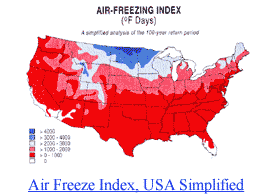



Climatic Data for
|

|
 Overview
OverviewA frost protected shallow foundation (FPSF) is a practical alternative to deeper, more-costly foundations in cold regions with seasonal ground freezing and the potential for frost heave. An FPSF incorporates strategically placed insulation to raise the frost depth around a building, thereby allowing foundation depths as shallow as 16 inches, even in the most severe climates (see comparison graphic ). The most extensive use has been in the Nordic countries, where over one million FPSF homes have been constructed successfully over the last 40 years. The FPSF is considered standard practice for residential buildings in Scandinavia.
The objective of this web page is to provide U.S. builders, designers, code officials, and others with the air freezing index (AFI) data necessary to employ FPSF technology. The AFI is a measure of the combined magnitude and duration of air temperatures above and below freezing during any given winter. The AFI, the thermal properties of the soil, and the surface soil cover are the major parameters used to determine the ground freezing potential of a given climate. The amount of insulation required to protect a foundation using FPSF technology has been found to be a function of the AFI. U.S. building codes and standards require use of the 100-year return period value AFI (F100) located in the far right column of the tables. The Mean Annual Temperature(MAT) map is used in designing requirements for FPSFs for unheated buildings can be found under Maps, and the MAT for each of 3011 U.S. weather stations can be found in the air freezing index (AFI) data tables. Cost savings to the buyers of new homes using FPSF have been estimated to range from 1% to 4% over the cost of conventional slab-on-grade construction or an annual savings of $300 million nationally. Additional long-term savings are expected from increased energy efficiency. Additional information on AFI is given in the documentation.
Additional information on FPSF is also available from the National Association of Home Builders that describes this technology in greater depth. In 2001, the American Society of Civil Engineers approved standard ASCE 32-01 and the International Code Council approved ASCE 32-01 for reference in the 2002 Addendas and 2003 Editions of the International Building Code and International Residential Code. The standards committee consisted of individuals from many backgrounds including consulting engineering, research, testing, manufacturing, construction, education, government, and private practice.
 References
References Farouki, O. (1992). European foundation designs for seasonally frozen ground. Monograph 92-1, U.S. Army Corps of Engrs., Cold Regions Res. & Engrg. Lab., Hanover, N.H.
Frost protected shallow foundations in Residential Construction, 1993. Phase I Report Prepared for the U.S. Department of Housing and Urban Development, NAHB Res. Ctr., Upper Marlboro, Md.
Frost protected shallow foundations in Residential Construction, 1994. Phase II Final Report Prepared for the U.S. Department of Housing and Urban Development, NAHB Res. Ctr., Upper Marlboro, Md.
Gumbel, E.J. (1958). Statistics of Extremes. Columbia University Press, New York, New York, 375 pp.
Heiersted, R.S. (1976). Frost I Jord (Frost Action in Ground). Committee on Frost Action in Soils, Royal Norwegian Council for Scientific and Industrial Res., Nr. 17, Oslo, Norway (in Norwegian).
Hughes, P.Y., E.H. Mason, T.R. Karl, and W.A. Brower (1992). United States Historical Climatology Network daily temperature and precipitation data. ORNL/CDIAC, NDP-042. Carbon Dioxide Information Analysis Ctr., Oak Ridge Nat. Lab., Oak Ridge, TN. 140 pp.
Jones, C.W., D.G. Miedema, and J.S. Watkins (1982). Frost action in soil foundations and control of surface structure heaving. Report No. REC-ERC-82-17, Bureau of Reclamation, Denver, Colo., 69 pp.
Kite, G.W. (1977). Frequency and risk analysis in hydrology. Water Resources Publications, Fort Collins, Colo., 224pp.
Linnel, K.A. and E.F. Lobacz (1980). Design and construction of foundations in areas of deep seasonal frost and permafrost. Special Report 80-34, U.S. Army Corps of Engrs., Cold Regions Res. & Engrg. Lab., Hanover, N.H.
Linsley, R.K., M. Kohler, and J.L.H. Paulus (1949). Applied Hydrology. McGraw-Hill Book Co., New York, New York, 689 pp.
Morris, R.A. (1988). Frost-protected shallow foundations: Current state-of-the-art and potential application in the U.S. Report prepared for the Society of the Plastics Industry, NAHB Res. Ctr., Upper Marlboro, Md.
Steurer, P.M. (1985): Creation of a serially complete database of high quality daily maximum and minimum temperatures. Nat. Oc. and Atmospheric Admin., Nat. Climatic Data Ctr., Asheville, N.C.
Steurer, P.M. (1989). Methods used to create an estimate of the 100-year return period of the air-freezing index. Frost-protected shallow foundation development program-Phase II final report, Appendix A. Prepared for the Society of the Plastics Industry, NAHB Res. Ctr., Upper Marlboro,
Steurer, P.M. and J.H. Crandell (1995). Comparison of methods used to create an estimate of the air-freezing index. J. Cold Reg. Engrg., 9(2), 64-74.
Steurer, P.M. (1996). Probability distributions used in the 100-year return period of the air-freezing index. J. Cold Reg. Engrg., 10(1), 25-35. Md.
 Related Sites
Related Sites